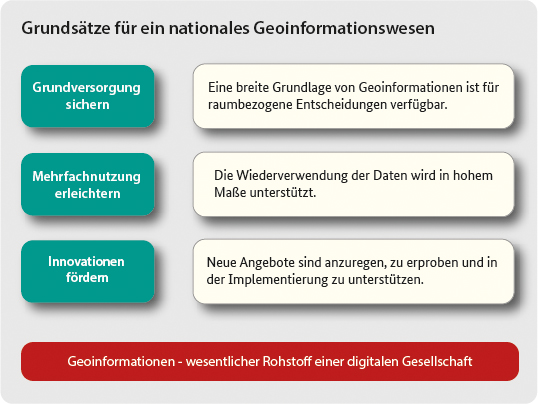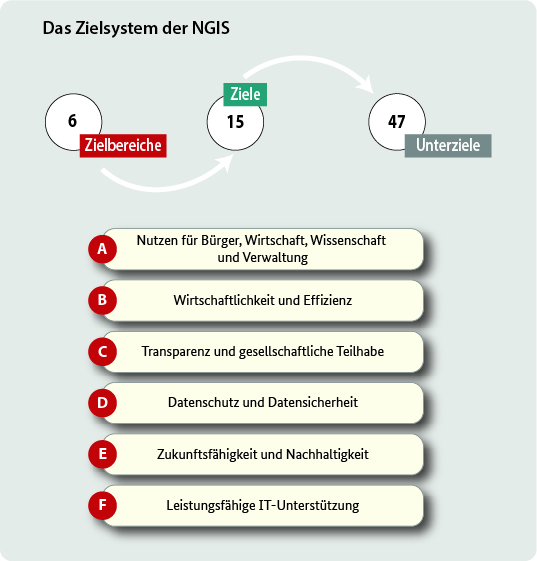
Based on Key Principles
Principles and Target System
The Structur of the NGIS
The NGIS was developed in 2015 and is primarily aimed at public administration, business and science bodies that collect, manage and provide geoinformation (providers) or that use geoinformation (users). Since the German geoinformation system is characterised by grown structures and numerous actors with different backgrounds, goals and opportunities, it is also important in this area of conflict to develop a common basic understanding and mutually supported goals with NGIS. Accordingly, the NGIS is thematically broadly based and is supported by three central principles, from which a comprehensive system of objectives is derived.
In order to implement the objectives, an operationalisation concept was developed in 2017, in which the corresponding measures are described. The practical application and actual use of geoinformation are the focus of the measures.
Principles
The NGIS defines three principles for the development of a future-oriented geoinformation system:
- Ensure a basic supply of geoinformation
- Facilitate multiple use of geoinformation
- Promoting innovation with geoinformation

Target systems
The goals of the NGIS are divided into six target areas, which are in line with the National E-Government Strategy and are transferred to the geoinformation system in Germany:
Target area A: Benefits for citizens, business, science and administration
Geoinformation has different potential uses for the individual user groups of our society. For this reason, geoinformation services directed both internally and externally must be oriented towards the purpose of the survey, but also towards the requirements of other users.
Target area B: Economy and efficiency
Multiple use of geoinformation according to the principle "collected once - used several times" can reduce costs and effectively activate the potential for added value.
Target Area C: Transparency and social participation
Geoinformation offers the opportunity to make political and social processes with spatial relevance more transparent. They create the basis for participation and commitment for all social groups to get involved in participation processes of public planning authorities (participation). Geo-information contributed by interest groups can support decision-making and continuation processes of the administration (cooperation).
Target area D: Data protection and data security
Data protection and data security are inseparably linked to the provision of geoinformation and are important prerequisites for ensuring the interests of the state, business, science and citizens.
Target area E: Future viability and sustainability
Geoinformation is indispensable for the social and political discourse on the orientation of state and society.
Target area F: Efficient IT support
The collection, management and provision of geoinformation as well as its networking and analysis require the use of powerful information and communication technology and nationwide broadband coverage in Germany. These guarantee the use of the National Technical Components of the GDI-DE and the development of potential uses.
The six target areas themselves contain 15 objectives with a total of 47 sub-objectives. Each of these goals is of great importance for a sustainable national geoinformation policy. In view of the distributed responsibilities and competences as well as the available resources, the implementation of the NGIS is carried out step by step with own measures and in a dialogue based on partnership.

Coordination office SDI Germany
Phone: +49 69 6333 258
E-Mail: mail@gdi-de.org
